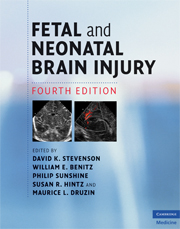Book contents
- Frontmatter
- Contents
- List of contributors
- Foreword
- Preface
- Section 1 Epidemiology, pathophysiology, and pathogenesis of fetal and neonatal brain injury
- 1 Neonatal encephalopathy: epidemiology and overview
- 2 Mechanisms of neurodegeneration and therapeutics in animal models of neonatal hypoxic–ischemic encephalopathy
- 3 Cellular and molecular biology of hypoxic–ischemic encephalopathy
- 4 The pathogenesis of preterm brain injury
- Section 2 Pregnancy, labor, and delivery complications causing brain injury
- Section 3 Diagnosis of the infant with brain injury
- Section 4 Specific conditions associated with fetal and neonatal brain injury
- Section 5 Management of the depressed or neurologically dysfunctional neonate
- Section 6 Assessing outcome of the brain-injured infant
- Index
- Plate section
- References
4 - The pathogenesis of preterm brain injury
from Section 1 - Epidemiology, pathophysiology, and pathogenesis of fetal and neonatal brain injury
Published online by Cambridge University Press: 12 January 2010
- Frontmatter
- Contents
- List of contributors
- Foreword
- Preface
- Section 1 Epidemiology, pathophysiology, and pathogenesis of fetal and neonatal brain injury
- 1 Neonatal encephalopathy: epidemiology and overview
- 2 Mechanisms of neurodegeneration and therapeutics in animal models of neonatal hypoxic–ischemic encephalopathy
- 3 Cellular and molecular biology of hypoxic–ischemic encephalopathy
- 4 The pathogenesis of preterm brain injury
- Section 2 Pregnancy, labor, and delivery complications causing brain injury
- Section 3 Diagnosis of the infant with brain injury
- Section 4 Specific conditions associated with fetal and neonatal brain injury
- Section 5 Management of the depressed or neurologically dysfunctional neonate
- Section 6 Assessing outcome of the brain-injured infant
- Index
- Plate section
- References
Summary
Introduction
Neurodevelopmental disability in prematurely born infants remains a very significant problem worldwide, for which there is no specific treatment. While there have been significant improvements in the survival of preterm infants, this has not been matched by improvements in morbidity; indeed there is some evidence that disability has increased, with a moderate rise in the childhood prevalence of cerebral palsy. The high incidence of neurological morbidity within this group of babies poses a considerable burden on families and the health system. We need to considerably increase our understanding of when and how this injury occurs to develop effective ways of alleviating the burden.
Traditionally, brain injury in preterm infants has been thought to reflect a fundamental vulnerability of the developing periventricular white matter to damage. However, recent evidence suggests a much more complex picture. In the present review, we will critically dissect the neuropathology of hypoxic preterm brain injury, including the underappreciated importance of acute gray-matter as well as white-matter damage, and the timing and mechanisms of injury, and highlight key unresolved issues.
The long-term problem: neurodevelopmental handicap
Children born preterm (<37 weeks) have high rates of disability including visual damage, mental retardation, epileptic seizures, and cerebral palsy. The incidence of these deficits increases steeply with decreasing gestational age and birthweight.
- Type
- Chapter
- Information
- Fetal and Neonatal Brain Injury , pp. 48 - 58Publisher: Cambridge University PressPrint publication year: 2009



